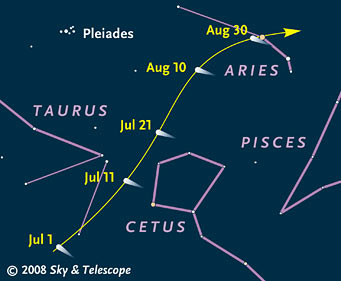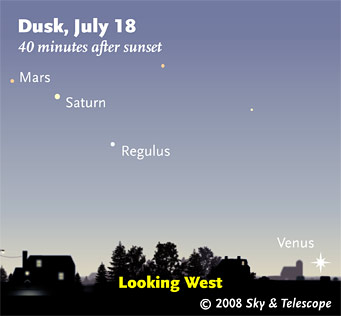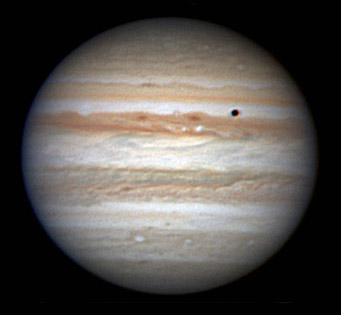Some daily events in the changing sky for July 11 – 19.
Space Station flyovers. The International Space Station is the biggest and brightest artificial satellite. When it crosses your sky it blazes as bright as Jupiter or even Venus, and it shows visible structure in an amateur telescope — if you manage to follow it with your scope.
This week the ISS has many good flyovers of North America. To see when and where to look, put your location and time zone into our Satellite Tracker.

In early and mid-July, when Comet Boattini is up before dawn in a moonless sky, it will be between the rump of Taurus and the head of Cetus. Your eastern horizon will cross this part of the sky at an angle that depends on your latitude, and a height that depends on the time you look. The best time will probably be about 5 to 15 minutes after the start of morning twilight; use our online almanac to find this time as described at left.
Comet Boattini is low in the east just before dawn. You'll need optical aid; it's only 6th magnitude — see our article and the chart at right. Here are pictures and a light curve (scroll down).
On July 6th, Brad Young of Tulsa, Oklahoma (latitude 36° north) found the comet "much brighter and bigger now than in spring. Easily found very low in the east at 4:30 a.m. CDT, with 12x60 binoculars on a dewy but clear morning. Approximately 6th magnitude and about 20 arcminute coma, no tail seen."
To find when morning twilight begins at your location, make sure you've put your location and time zone into our online almanac. If you're on daylight saving time like most of North America, make sure the Daylight Saving Time box is checked.
------------------------
Friday, July 11
For the times of all Red Spot transits this month, visible worldwide, see the July Sky & Telescope, page 66.
Saturday, July 12
Sunday, July 13
Monday, July 14
Tuesday, July 15
Wednesday, July 16
Thursday, July 17
Friday, July 18
Saturday, July 19

As the summer progresses, Venus gradually creeps up into view just above the sunset horizon.
Sky & Telescope diagram
Want to become a better amateur astronomer? Learn your way around the constellations. They're the key to locating everything fainter and deeper to hunt with binoculars or a telescope. For an easy-to-use constellation guide covering the whole evening sky, use the big monthly foldout map in each issue of Sky & Telescope, the essential magazine of astronomy. Or download our free Getting Started in Astronomy booklet (which only has bimonthly maps).
Once you get a telescope, to put it to good use you'll need a detailed, large-scale sky atlas (set of maps; the standards are Sky Atlas 2000.0 or the smaller Pocket Sky Atlas) and good deep-sky guidebooks (such as Sky Atlas 2000.0 Companion by Strong and Sinnott, the even more detailed Night Sky Observer's Guide by Kepple and Sanner, or the classic Burnham's Celestial Handbook). Read how to use them effectively.
More beginners' tips: "How to Start Right in Astronomy".
This Week's Planet Roundup
Mercury (about magnitude –1) is low in the dawn. Look for it above the east-northeast horizon about 45 minutes to an hour before sunrise. Don't confuse it with Aldebaran far to its upper right, or Capella far to its upper left.
Venus is very deep in the glow of sunset. Look for it just above the west-northwest horizon shortly after sunset. Bring binoculars.
Mars and Saturn (magnitudes +1.7 and +0.8) are getting ever lower in the west at dusk, as shown in the scene above. They were in conjunction, 0.7° apart on July 10th, and they remain less than 2° apart through the 13th. And Regulus (magnitude +1.4) twinkles down to their lower right. Look early before they sink too low and set!

Lots is happening on Jupiter! In this first-rate stacked-video image from June 26th, Christopher Go caught the very beginning of a white outbreak (small, sharp bright spots) in the North Equatorial Belt (NEB, the dark red-brown belt just above center). The black dot is the shadow of Europa, with Europa itself following behind it (to the left; celestial east) by about a fifth of the planet's width.
Go also writes, "Note the dark oval at the NEBn. Note also the large white oval at the [edge of the] NEBn. The white bar in the [white] North Temperate Zone is fading, and note the dark formation on its southern edge. The southern polar area is notably dark." North is up (but remember that many telescopes show south up).
And on the other side of Jupiter, the third, newest, and littlest Red Spot has just been swallowed by the Great Red Spot (GRS); see article. The GRS remains near System II longitude 121°.
Jupiter (magnitude –2.7, in Sagittarius) shines low in the southeast in twilight, left of the Sagittarius Teapot and just below the smaller, dimmer Teaspoon. Jupiter is highest in the south around midnight daylight saving time.
Uranus and Neptune (magnitudes 6 and 8, respectively, in Aquarius and Capricornus) are high in the southeast and south before the first light of dawn. Use our article and finder charts.
Pluto (magnitude 14.0, in northwestern Sagittarius) is highest in the south around 11 p.m.
All descriptions that relate to your horizon or zenith — including the words up, down, right, and left — are written for the world's mid-northern latitudes. Descriptions that also depend on longitude (mainly Moon positions) are for North America. Eastern Daylight Time (EDT) equals Universal Time (UT, UTC, or GMT) minus 4 hours.
----------------------
To be sure to get the current Sky at a Glance, bookmark this URL:
http://SkyandTelescope.com/observing/ataglance?1=1
If pictures fail to load, refresh the page. If they still fail to load, change the 1 at the end of this URL to any other character and try again.
 0
0
Comments
You must be logged in to post a comment.